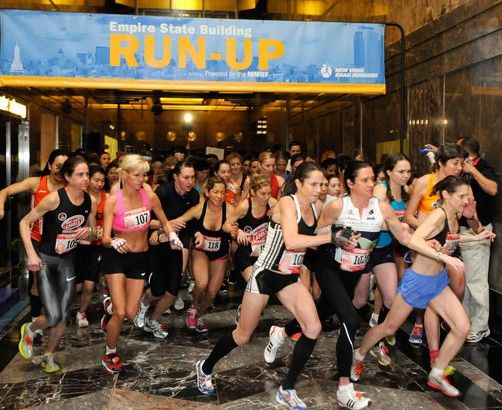The Empire State Building is a New York City landmark that has captivated me since I moved to NYC almost two years ago. Maybe I’m fond of it because it exemplifies “New York,” or because I know my great grandparents also peered up its monolithic backbone after emigrating to NYC. Perhaps I love it because it was a faithful compass when I was adjusting to the initially overwhelming transit system. Where am I… uptown? Downtown? Accidentally in Brooklyn? Look for the ESB high in the sky and, voila, coordinates illuminated. Either way, when I learned that New York Road Runners (NYRR) offered an annual Empire State Building Run-Up, I was immediately intrigued.
But when the opportunity to climb my favorite NYC peak arose, I momentarily froze. 1,576 steps… that’s a lot, roughly 1,550 more steps than I climb in an average day (or week?!). Having been a sluggish library dweller throughout my first semester of medical school, I was not feeling in my best tower-running shape. Walking two flights with a textbook-laden backpack would catapult me into dyspnea, as we med-schoolers say. Regardless, the initial decision was not mine to make: I had to enter a random lottery to win one of the race’s few hundred spots. It was worth a shot.
My motivation for scaling the ESB? Well, the chance to train for a tangible event. The athletic prowess it would require. The challenge. But also, the “have you heard of the Empire State Building? Ya, I conquered it” factor. Perfect fodder for a game of “two truths and a lie.” An alluring fact to casually mention on a first date. An excellent resume closer. After all, running up the Empire State Building has legitimate wow-factor.
In mid-December, the congratulatory acceptance email plopped into my inbox. I smiled. I tensed up. I had an anxiety dream that night in which I pathetically collapsed on the 12th floor. But overall I was really excited. King Kong scaled it, why can’t I?
Time to train… but what does that mean? My pre-competition research proved unfruitful. How tall is each step? What is considered a “good” finishing time? How should I approach the course?
My questions unanswered, I resolved to train on the StairMaster, my most practical access to 1,500+ steps. So I climbed and climbed, without going anywhere but in place. But over time my stairway breathlessness improved and my muscle memoryseemingly took the steps for me. I graduated to some fancy footwork — sideways StairMaster, backwards StairMaster, two-step StairMaster — and felt pretty good about myself… until I tried my first real stairway workout. The kicked-up dust and the lingering stale air were moderately suffocating, resulting in an unpleasant hack and faint dizziness. I decided to take a chance by forgoing the real stairs to focus on my stationary gym-pal. Perhaps a training method for the faint-hearted, but it worked for me.
On race night in February, I anxiously walked to 350 5th Avenue during one of NYC’s few snowy moments this winter. The ESB, which changes colors nightly, was illuminated orange for the NYRR. Upon arriving, I waited for my allotted time slot alongside 600+ competitors. To say the energy in the wait room was pulsing is an understatement, partly thanks to the Mullet Marathoners. Unlike previous years, racers were staggered in heats with 5-10 seconds between each individual (the professionals, however, still began as a group).
When my time trial neared, I headed to the marble-coated lobby for the start. Then… ready, steady… up, up and away!
I spiraled up the stairs. Weeee! This is fun! The first twenty flights flew by. The 30th lurked ahead. Each succeeding flight seemed to be spaced further from the one before, but I maintained my desired tempo. Runners stayed on the right, passers on the left, with the stairs no wider than two bodies across. By the 70th floor, I could feel my airways constricting. But I huffed, and I puffed, and I closed in on floor 86, 0.2 miles in the orange-glowing sky. Greeted by snow flurries, cheering NYRR staff, and a medal, I crossed the finish line on the observatory deck in just over 19 minutes. Success.
My fiery cough arrived immediately. The cool air on the deck and the subsequent elevator ride never felt so rewarding. After leaving the ESB, I washed down the year-old, musty stairway dust with a well-deserved beer. I looked back to NYC’s tallest peak with quiet triumph. Since that day, I still feel joyful when I see the building’s unmistakable form piercing the skyline. Empire State Building: Conquered. Next? The list of possible stair races goes on…
What I learned for next time?
- Stair climbing is quite different from running. A decent mile time does not necessarily translate into stairway fitness.
- The steps are on the smaller side; two-at-a-time is most efficient. To sneak a peak at the racecourse, click here.
- Not all flights are created equal: The last few flights in the 86 stories have a handful of goading extra steps.
- The handrail should be manhandled, not daintily grasped. Enlist arm strength to hoist yourself up.
- Start slowly and work up to quicker climbing speeds. Starting strong to pass nearby climbers early on only leaves you choking for air.
- Pass on the stairs or the landings, not on the turns.
- Sprinting may be a bad idea, unless you envision clocking in around the record time of 9:33 minutes. Yes, that equates to 6-7 seconds per flight.
- Fighting for air is the most challenging aspect of the race.
How can I sign up?
Throughout the race’s 35-year history, only 5,000 competitors have completed the exclusive vertical climb. To guarantee a spot, join the Multiple Myeloma Research Foundation’s (MMRF) fundraising team. Otherwise, look out for the random lottery sign-up on NYRR’s race page in early December.
Photo: Action.com/New York Road Runners

